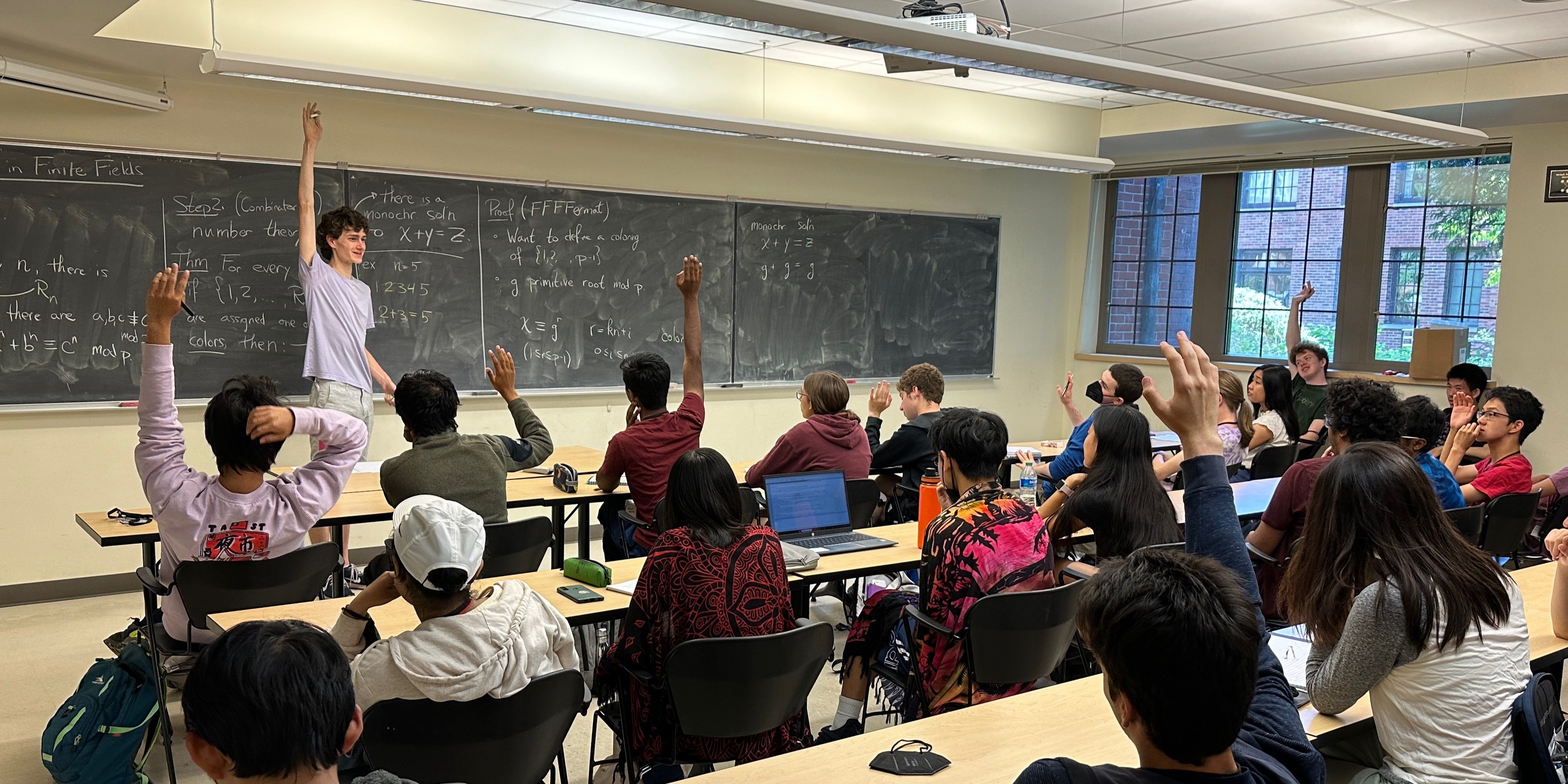Teaching

In my experience, good teaching is a blend of mathematics knowledge, understanding of student learning, performance, and empathy; and it requires both thoughtful preparation and comfort with improvisation. For me, the emotional payoff from a successful class, from seeing new understanding flash across a student's face, or from crafting and telling a carefully plotted mathematical story, is huge—I can ride that high for days. Which is why teaching, in a variety of forms, is one of the most challenging and rewarding activities I do as a graduate student.
This page summarizes my teaching history, across summer math camps, middle school enrichment programs, mentoring, and fun mathematics lectures. I've taught in several settings and enjoyed them all, and I'm always on the lookout for more! If you're looking for someone to give a fun, engaging math talk or help with an outreach program or generally spread math enthusiasm, let me know! Chances are, I'd love to be a part of it.
Classroom teaching
I've been a TA for multivariable calculus and discrete geometry classes at MIT. I also taught for three summers at Canada/USA Mathcamp, a five-week summer program for high school students who love math. One of the joys of teaching there is the freedom instructors have to design their own classes, both in subject and in style. Here are the classes I've designed and taught there:
2024
- Graph inequalitites by magic (graph homomorphism inequalities) Notes
- The quest for atonal spheres (math in music theory)
- Calculus wars (history of math)
- Toppling sandpiles (the sandpile group) Notes
- Graph on, graph off (limits of graph sequences) Notes
- Ghostly graphs (spectral graph theory)Notes
- Fermat is false in finite fields (number theory and graph theory)
- 4 dimensions is easy (unit distance problem)
- Rethinking education (seminar on design for education systems)
2023
- Discrete calculus
- First, choose randomly (probabilistic method in combinatorics)
- Back to basi(c)s (linear algebraic methods in discrete geometry)
- The Ra(n)do(m) graph (graph theory meets logic) Notes
- The transcendence of a single number (Liouville's constant)
- The hat-xiom of choice (construction of a non-measurable set)
- Lastly, choose randomly (Lovász local lemma)
2022
- The mathematics of forbidden words (symbolic dynamics)
- Counter? I hardly know 'er! (enumerative combinatorics)
- Diophantine approximation Notes
- High-dimensional potatoes (combinatorial convex geometry)
- High-dimensional oranges (volume concentration on the sphere)
- Counting with linear algebra
- Greed (matroids)
- How to talk the talk (seminar on mathematical speaking)
Mentoring & outreach
Programs I've worked with
I worked at Canada/USA Mathcamp in 2018 as an undergraduate, and in 2022, 2023, and 2024 as an instructor. I was also a semi-organizer and a tutor at Maths Beyond Limits, a fantastic two-week residential mathematics program in Poland, in 2023 and 2025. In 2023 and 2024, I was a mentor with MIT PRIMES, a mathematics research program for high-school students.
When I was an undergraduate, I helped facilitate a mathematics enrichment program at a middle school in Kimberly, Wisconsin. And when I studied abroad in Budapest, I was a volunteer enrichment instructor at the Budapest Derkovits School, where I designed math enrichment activities for primarily Hungarian-speaking students.
For my undergraduate thesis, I wrote a book whose goal is to bring the experience of thinking mathematically to a broad audience. (You can read the introduction and the first chapter here).
Fun math talks
I like stories (both reading and writing them), and the math I like best is told as a story: travelling from one place to another by an unexpected path, with twists and turns that weave old concepts into new understanding, finally reaching a surprising and satisfying ending.
I believe that storytelling is an effective way to connect with people and spread awe, wonder, and excitement, and mathematics is no exception to this. Stories aren't just for kids, either: A good mathematical story can inspire an undergraduate student and infuse them with enthusiasm, or lift a graduate student out of a research funk and remind them of what they love.
This principle guides all of my teaching, but it's especially notable in my broad-audience math talks, colloquia, and seminars, where my goal is to inspire, excite, and simply have a good time. Here are some of the topics I've shared with high school students, undergrads, and Ph.D. students:
- The Ra(n)do(m) graph: A story told through probability, graph theory, logic, and a classic Arlo Guthrie song.
- Hat games & unmeasurable sets: The construction of a nonmeasurable set via logic puzzles.
- (Almost) equiangular vectors: Ties together geometry, linear algebra, and probability to give an introduction to the strangeness of many-dimensional space.
- 4 dimensions is weird: An introduction to some strange things that can happen in 4 dimensions, and how to think about them in a structured way.
- The quest for atonal spheres: A journey from 20th-century experimental music to abstract mathematics, with elements of group theory, combinatorics, probability, and measure theory.
- Compactness in combinatorics: Uses surprising applications of topology in combinatorics to shed light on the definition of compactness, which is one of the most mysterious concepts students come across in their first topology course.
- Calculus wars: A story about the origins of calculus, filled with ambition, jealousy, secrecy, political maneuvering, and the dawn of the Enlightenment era. It's a story about two titans of science, their lives and their legendary clash, and what it was like to be a scientist in the 1600s.
- Fermat is false in finite fields: Combines graph theory, number theory, and group theory to prove that Fermat's Last Theorem is not just untrue in finite fields, but extremely, outlandishly false.
- Fire and chaos: A talk about understanding fractals, and how to use that to draw really pretty pictures.
If these sound intriguing and you're interested in having me present a mathematical story at your institution, let me know! I'm always glad to share joy in math.